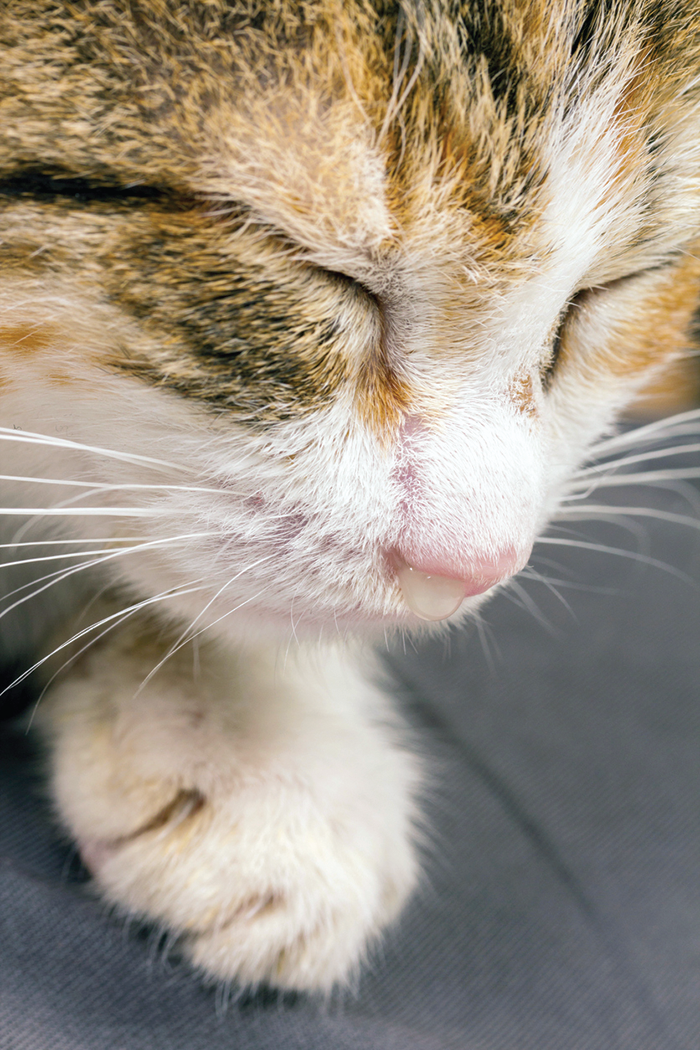Viruses cause most feline upper-respiratory infections (URIs). While many of these infections are mild and resolve without medical intervention, stress can make things worse. So, since going to the veterinary clinic is stressful for cats, it’s smart to know when veterinary care is necessary and when a “wait-and-see” decision is right for your cat.
If your cat starts sneezing, with or without clear nasal discharge, and has no other symptoms (appetite is fine, he is behaving normally), the best advice is to wait before scheduling a veterinary appointment.
If symptoms do not progress to include thick, discolored nasal discharge, lethargy, and loss of appetite, and if the sneezing resolves within seven to 10 days, you’re all set. Your cat may have had a mild viral upper respiratory infection that self-resolved. It’s a common scenario. Cats whose symptoms worsen or last longer, however, should be seen by a veterinarian.
Secondary Infections
The two most common respiratory viruses in cats are feline herpesvirus 1 (FHV-1) and feline calicivirus (FCV).
The inflammation caused by these viruses compromises the integrity of the lining of the respiratory tract, which allows bacterial invaders to come in and take advantage. The result of these secondary bacterial invaders is that classic, miserable-looking, congested, sneezing kitty with purulent discharge (known as “pus”) coming from the cat’s eyes and nose.
This secondary infection usually needs to be treated with antibiotics, as the infection can spread deeper into the cartilage and bones of the nasal passages and sinuses. If it does, the result can be permanent damage and chronic upper-respiratory symptoms. The presciption for an antibiotic therapy may be required for weeks, depending on the extent of the cat’s bacterial invasion.
The viral component of URIs can be chronic and recurring in an individual cat, especially with the herpesvirus. Again, stress is a known cause of reactivation of the virus, not unlike in humans with herpesvirus cold sores.
“Minimizing stress is essential for lessening severity of signs and recurrence,” says Dr. Erin Henry, instructor of Shelter Medicine, Maddie’s Shelter Medicine Program, Cornell University College of Veterinary Medicine.
While this is especially true in the shelter environment, where overcrowding and less-than-ideal environmental conditions sometimes occur, Dr. Henry says the same is true for cats in a home environment, which many cat owners do not realize.
“Studies have shown that all of the primary agents involved in URI for cats can also be found in asymptomatic cats. It is suspected that stress contributes to the pathogens’ ability to invade the respiratory tissues and cause clinical signs,” she says.
“A stressful event in the home can cause a weakening of the immune response, allowing a pathogen like feline herpesvirus to recrudesce. Cats in a home environment are more likely to clear a viral URI with no additional treatment when it is a low-stress environment,” says Dr. Henry. (See our sidebar “Combating Stress” for ways to help you reduce your cat’s anxiety in his own home.)
Treatment Options
Clearly, you need your veterinarian’s help to get the proper antibiotics, but there’s a lot you can do at home to help your cat get through an upper respiratory infection as quickly and comfortably as possible. In addition to administering the antibiotics prescribed by your veterinarian, consider nebulizing (inhalational steam therapy) by confining your cat in a bathroom while running a nice, hot, steamy shower.
The moist steam helps soften and loosen thick upper-respiratory secretions so your cat can clear them more easily. Similarly, you can purchase an over-the-counter nasal saline spray made for humans and instill one drop in each nostril twice daily, which also helps loosen up secretions.
Congested cats can’t smell their food very well, which sometimes leads to disinterest in eating. Warming canned food in the microwave for a few seconds (literally, like 10 to 12 seconds) helps intensify the aroma, thereby helping maintain appetite. Don’t feed it to your cat while it’s hot. You’re looking for warmly aromatic!
Prevention
Minimize stress, of course, but you can also supplement your cat’s diet with l-lysine, an amino acid that is thought to interfere with viral replication. While the efficacy of l-lysine has recently been called into question, there are anecdotal reports of this helping prevent recurrences. It is worthy of a conversation with your veterinarian about how it may help your cat.
Supplementing with the probiotic Fortiflora (Purina) showed promise in a preliminary study (“Pilot study to evaluate the effect of oral supplementation of Enterococcus faecium SF68 on cats with latent herpesvirus 1,” Lappin et al, J Feline Med Surg. August 2009;11(8):650-4).
Further studies are underway to assess probiotics ability to lessen stress-related recurrences of infection. However, because this product is safe, easily available, and may be good for your cat’s health in other ways, it is definitely something to consider to help your cat with stress-related infection.




